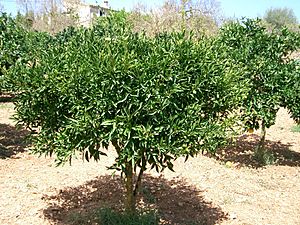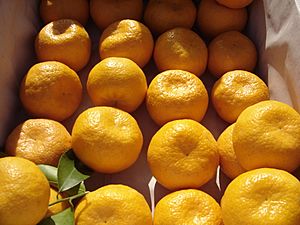Citrus × deliciosa facts for kids
Quick facts for kids Citrus × deliciosa |
|
|---|---|
 |
|
| Hybrid parentage | Parents unknown; mandarin orange with some pomelo ancestry |
| Cultivar | "Mediterranean"? |
| Marketing names | Willowleaf, Ba Ahmed (Morocco), Blida, Boufarik and Bougie (Algeria), Bodrum (Turkey), Paterno and Palermo (Italy), Nice and Provence (France), Valencia (Spain), Setubalense (Portugal); commune (French), comuna (Spanish), gallego (Portuguese), koina (Greek), yerli (Turkish), and beladi (various spellings, Arabic); Effendi or Yousef Effendi (Egypt and the Near East), Emperor, Avana or Speciale (Italy), Thorny (Australia), Mexerica or Bergamota (Brazil), Montegrina, Natal, and Chino or Amarillo (Mexico). |
| Origin | Italy |
The Citrus × deliciosa is a special type of mandarin orange. It's also known by names like Willowleaf Mandarin or Mediterranean Mandarin. This fruit is a hybrid citrus, meaning it's a mix of different citrus plants. It has a little bit of pomelo in its family tree.
This delicious mandarin first appeared in Italy around 1810 to 1818. From there, it spread widely across the Mediterranean region. It became one of the most important citrus fruits grown. People love its sweet taste. The fruit is eaten fresh, and its peel is used to add flavor to foods and drinks. Even the leaves are used to make a special oil called petitgrain oil. The flowers also have a lot of essential oils.
Its scientific name, Citrus × deliciosa, means "delicious citrus." This name fits perfectly because many people think it's one of the tastiest citrus fruits!
About the Mediterranean Mandarin
This mandarin has been enjoyed for a long time. However, growing it has become a bit tricky. The fruits can spoil quickly, and the trees sometimes produce a lot of fruit one year and very little the next. Even with these challenges, many people still love its strong citrus smell and taste.
Because of its unique flavor, this mandarin is still important in certain markets. For example, in Portugal, there's a special type called "Citrinos do Algarve" that has a Protected Geographical Indication (PGI). This means it's a high-quality product from a specific area. The Mediterranean mandarin is also good for organic farming because it's not much affected by a common fruit fly called Ceratitis capitata.
Different Types (Cultivars)
There are several different kinds, or "cultivars," of the Mediterranean mandarin. Each one might have slightly different features, like taste or how it grows. Some popular types include:
- Avana
- Emperor
- Yousef Effendi
- Comuna/commune
- Natal (from Mexico)
- Paterno
- Willowleaf (popular in the USA)
- Setubalense
Its Citrus Family Tree
The Citrus × deliciosa is also a parent to many other interesting citrus fruits. This means it was crossed with other citrus plants to create new types. Here are some of its famous "children":
- 'Clementine' (a mix of Citrus × deliciosa and an unknown sweet orange)
- 'Kinnow' (a mix of Citrus × deliciosa and King tangor)
- 'Wilking' (another mix of Citrus × deliciosa and King tangor)
- 'Encore' (also a mix of Citrus × deliciosa and King tangor)
- 'Temple' (a mix of Citrus × deliciosa and an unknown sweet orange)
- 'Cravo' (a mix of Citrus × deliciosa and an unknown sweet orange)
- 'Amoa 8' (a mix of 'Avana' mandarin and 'Moro' orange)
- 'Allspice' tangelo (a mix of 'Willowleaf' mandarin and 'Imperial' grapefruit)
- 'Pearl' tangelo (another mix of 'Willowleaf' mandarin and 'Imperial' grapefruit)


